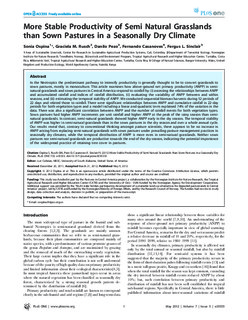More stable productivity of semi natural grasslands than sown pastures in a seasonally dry climate
Journal article, Peer reviewed
Published version

Åpne
Permanent lenke
http://hdl.handle.net/11250/2505965Utgivelsesdato
2012Metadata
Vis full innførselSamlinger
- Publikasjoner fra CRIStin - NINA [2364]
- Scientific publications [1392]
Originalversjon
10.1371/journal.pone.0035555Sammendrag
In the Neotropics the predominant pathway to intensify productivity is generally thought to be to convert grasslands to sown pastures, mostly in monoculture. This article examines how above-ground net primary productivity (ANPP) in seminatural grasslands and sown pastures in Central America respond to rainfall by: (i) assessing the relationships between ANPP and accumulated rainfall and indices of rainfall distribution, (ii) evaluating the variability of ANPP between and within seasons, and (iii) estimating the temporal stability of ANPP. We conducted sequential biomass harvests during 12 periods of 22 days and related those to rainfall. There were significant relationships between ANPP and cumulative rainfall in 22-day periods for both vegetation types and a model including a linear and quadratic term explained 74% of the variation in the data. There was also a significant correlation between ANPP and the number of rainfall events for both vegetation types. Sown pastures had higher ANPP increments per unit rainfall and higher ANPP at the peak of the rainy season than seminatural grasslands. In contrast, semi-natural grasslands showed higher ANPP early in the dry season. The temporal stability of ANPP was higher in semi-natural grasslands than in the sown pastures in the dry season and over a whole annual cycle. Our results reveal that, contrary to conventional thinking amongst pasture scientists, there appears to be no increase in ANPP arising from replacing semi-natural grasslands with sown pastures under prevailing pasture management practices in seasonally dry climates, while the temporal distribution of ANPP is more even in semi-natural grasslands. Neither sown pastures nor semi-natural grasslands are productive towards the end of the dry season, indicating the potential importance of the widespread practice of retaining tree cover in pastures. More stable productivity of semi natural grasslands than sown pastures in a seasonally dry climate
